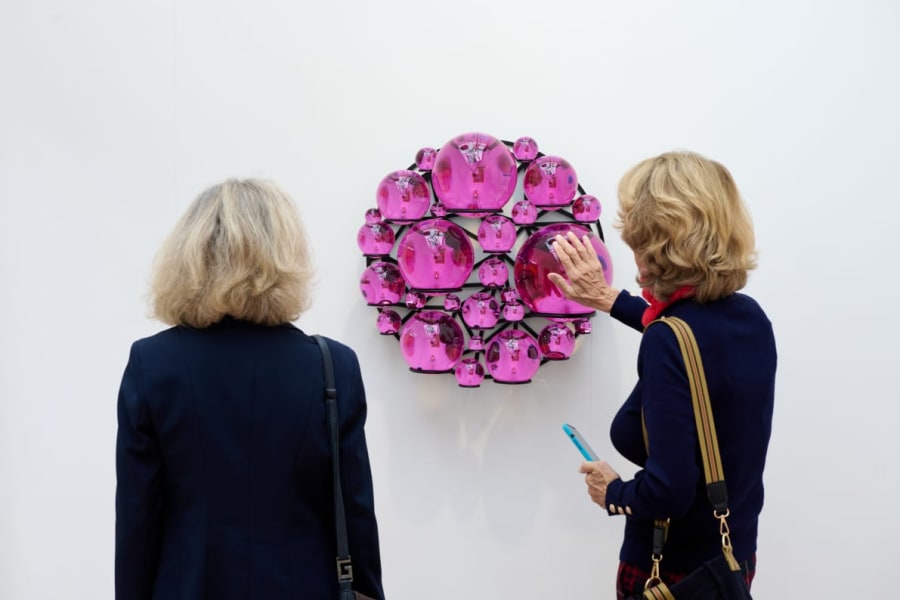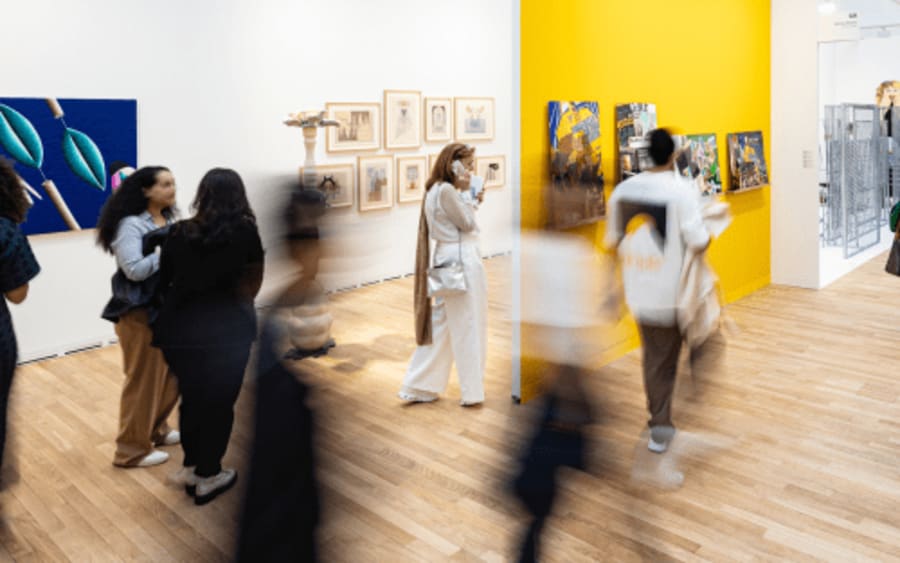In times of economic uncertainty, conventional wisdom suggests that collectors retreat to the familiar, favoring blue-chip names and traditional media such as painting and sculpture over experimental or emerging work.
Not so when it comes to women, who now hold more than a third of global wealth – a figure projected to rise to almost 40% by 2030. According to the latest Art Basel and UBS Survey of Global Collecting, female collectors are reshaping the art market by taking bolder risks with their acquisitions – showing a greater willingness than men to back emerging artists, embrace new media, and deviate from prevailing trends. This challenges the long-held assumption, particularly pervasive in economic discourse, that women are inherently more risk-averse. As the report’s author, Dr. Clare McAndrew, observes, women often take bigger risks in areas aligned with social impact, self-expression, and identity – traits that increasingly define collecting behavior today.
According to the report, women allocated a lower share of spending to traditional mediums such as paintings than men and had higher shares of digital art and photography; last year women allocated 16% of their spending to digital art (compared with 13% for men) as well as more on photography (11% versus 8%).
The digital art collector Audrey Ou, whose family established Shanghai’s Rockbund Art Museum in 2010, says she approaches collecting not through the lens of risk but of ‘alignment and intention.’ In 2021, she cofounded TRLab, a platform dedicated to collecting NFTs. Ou notes that women and younger buyers are showing a growing interest in digital art – a trend reflected in the Survey of Global Collecting, where it now ranks third in terms of spending, almost on a par with sculpture. She attributes this shift to ‘a generational mindset shaped by openness and curiosity.’ As Ou puts it: ‘Younger collectors, especially Gen Z, are used to forming opinions from a multitude of sources. They’ll visit galleries, but they also do their own research, connect directly with artists, and cultivate relationships organically online. That immediacy and access just feels natural to them.’
Even so, Ou notes that few young people are actively buying digital art – for now. ‘What I do see is a growing interest in engaging with it,’ she says. ‘They are following digital artists, attending talks around digital tools, and exploring how technology expands what art can be.’ Many, she observes, first encounter the medium through collaborations or participatory projects rather than the market itself. The accessibility of digital art is what will ultimately draw more people in, Ou adds.
Another area where women are showing a greater appetite for risk is in the emerging art market. The report finds that female collectors are far more inclined to back unknown names, with 55% saying they frequently or often buy works by artists without an established reputation – compared with 44% of men. This is despite more than half of all respondents describing such purchases as high-risk. What emerges is a picture of a collecting culture driven less by speculation and more by conviction, one that is helping to elevate artists who have too often been overlooked, particularly women.
The motivation behind these choices appears to extend beyond financial return. As Christl Novakovic, the head of UBS Global Wealth Management EMEA, notes in the report’s foreword, female investors and collectors ‘tend to take a long-term, purpose-led approach,’ guided by ‘impact, research, and risk awareness.’ This sensibility signals a move towards a more conscientious form of patronage, where collecting is as much about redressing imbalance as it is about building value.
According to Ou, many younger women are drawn to artists whose ideas or narratives resonate with them personally. ‘Often, that support extends beyond collecting,’ she notes. ‘They may help with organizing exhibitions or making helpful introductions. There’s an inherent sense of community-building in how many women collect today. It’s less about following trends and more about using collecting to express one’s own perspective and voice.’
The London-based collector and tax lawyer Liesl Fichardt stresses that risk management is still ‘an essential part of collecting’ for her and fellow female collectors. ‘We are cautious, but we are also willing to take a chance and back an artist. Women are rewriting the rules of collecting in a gutsy way,’ she says. ‘It is not necessarily about the type of art or media, it’s more substantive. It’s about the art and the artist and how they can be supported – whether newly discovered or established, whether in photography or painting.’
Perhaps unexpectedly, the latest Survey of Global Collecting suggests that Gen Z collectors are proving to be more cautious than their predecessors. Their relative youth – and correspondingly lower levels of wealth – may partly explain this tendency. As the report notes, the greater the financial cushion, the higher the appetite for risk.
Fichardt observes that a ‘significant generational transfer of wealth’ has already taken place, reshaping the tax landscape and, with it, collecting habits. What is emerging, she says, is ‘a new set of values’ underpinning how younger buyers engage with art. Collecting today, she notes, is becoming less about acquiring trophy works and more about cultivating relationships – whether through visiting artists’ studios, developing closer ties with galleries, or contributing to how institutions collect and exhibit art.
In recent months, the notion of art as a reliable asset class has lost traction, with a growing chorus of voices calling for a return to a valuation of art that looks beyond the purely transactional. Fichardt observes that collecting is already shifting away from a ‘clinical’ investment approach towards something more rooted in personal connection. ‘Art as an asset class isn’t going anywhere,’ she says. ‘It’s simply being redefined.’
The British former hedge-fund manager and collector Christian Levett believes that art can only function as an asset class if it is ‘top tier blue chip, the best of the best.’ A self-described cautious investor, Levett has long favored stability over speculation. Even as he has shifted his focus exclusively to women artists, his collection leans towards established names such as Leonor Fini, Leonora Carrington, Joan Mitchell, and Lee Krasner.
For Levett, quality remains the surest hedge against volatility. ‘If you buy an artwork of exceptional quality, with strong provenance and exhibition history – or even if it lacks those but still stands out – you give it the best chance of holding its value,’ he says. ‘So you’re not even thinking about whether it’s going up or down in price.’
He advises collectors, particularly those buying contemporary works, to assume that you will hold onto a work for at least 10 years, if not much longer. ‘Only buy what you’ll be happy to live with long-term,’ he cautions. ‘There should be no expectation of price appreciation, especially if the artist isn’t already well known. Even when they are, there’s no guarantee the value will hold.’
Yet Levett acknowledges that expectations inevitably shift as the stakes rise. ‘Once you start spending in the hundreds of thousands or millions, of course you hope a work holds or even increases in value,’ he admits. ‘But that only happens when demand significantly outstrips supply.’
Ultimately, as Fichardt points out, collecting remains an act of faith, irrespective of age or gender. ‘Art is a high-risk investment,’ she says. ‘But it’s also deeply rewarding, whether you’re living with a great painting you never plan to sell, or watching it become something truly coveted on the market.’
Anny Shaw is a UK-based writer, editor and speaker. She is a contributing art market editor at The Art Newspaper, critic for the London Standard and commissioning editor for Art Basel Stories. Anny has been a regular guest on The Week in Art podcast and has written for publications including the Financial Times, The Times, the Guardian, The World of Interiors, and Apollo.
Caption for header image: View of Kiang Malingue's booth at Art Basel 2025.
Published on November 11, 2025.


